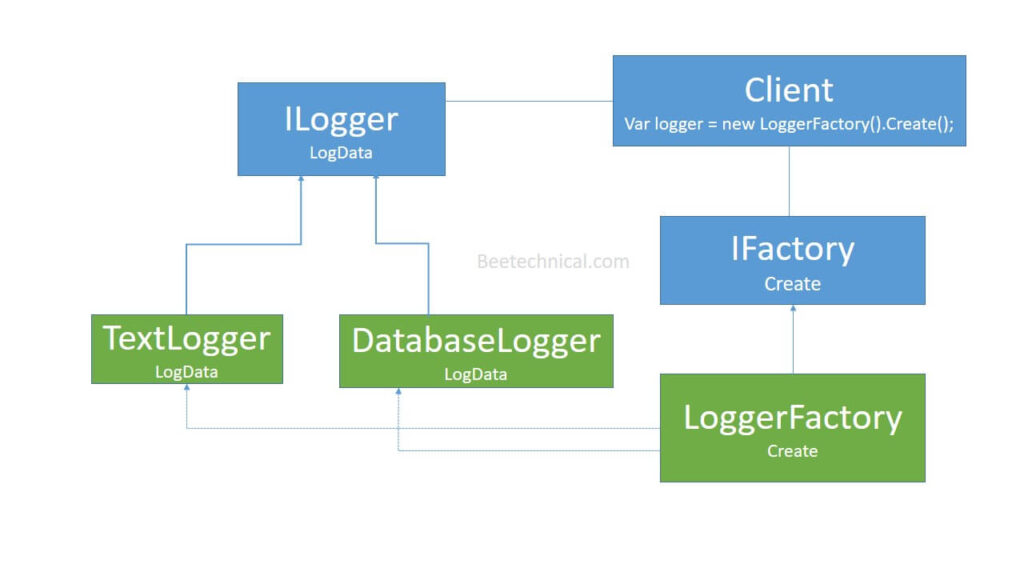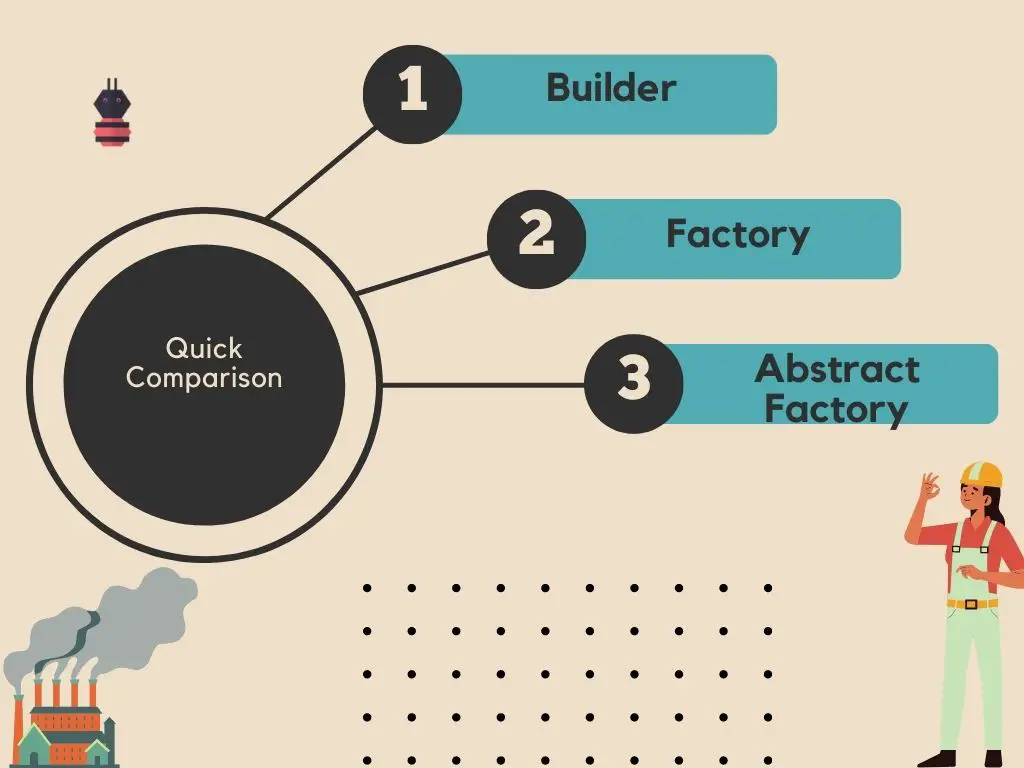The Factory Design Pattern is a creational design pattern in object-oriented programming that provides a way to create objects without specifying the exact class of object that will be created.
Instead of directly creating objects using a constructor, the Factory Pattern defines an interface for creating objects and delegates the responsibility of object instantiation to subclasses. The Factory Method acts as a creator that returns objects of a certain type, based on the input parameters provided.
This allows for loose coupling between the client code and the actual implementation classes, making it easier to switch between different implementations without modifying the client code.
When to use the Factory Design Pattern?
The Factory Design Pattern can be used in situations where there is a need for flexibility in object creation, and where the specific class of object that will be created is not known at compile-time. Here are some scenarios where the Factory Design Pattern can be useful:
- Complex object creation: When object creation requires complex logic and multiple steps, using a factory method can encapsulate this logic and simplify the client code.
- Object creation based on runtime information: In situations where the type of object to be created depends on runtime information, such as user input or system configuration, a Factory Method can be used to select the appropriate implementation.
- Object creation from a common interface: When multiple objects implement the same interface or have a common parent class, a Factory Method can be used to create objects of different types while still maintaining consistency in the interface.
- Testability: Using a Factory Method can make it easier to test client code, as it allows for the creation of mock objects and simplifies dependency injection.
- Centralizing object creation: By centralizing object creation in a factory method, it becomes easier to modify the object creation process without modifying the client code.
Advantages of using the Factory Design Pattern
The Factory Design Pattern offers several advantages in object-oriented programming:
- Loose coupling: The Factory Method decouples the client code from the actual implementation classes, making it easier to switch between different implementations without modifying the client code.
- Abstraction: The Factory Method provides an abstraction layer that hides the implementation details of object creation, allowing clients to focus on the interface rather than the implementation.
- Flexibility: The Factory Method allows for flexibility in object creation, as it can create different types of objects based on runtime information or configuration, without the need to change the client code.
- Extensibility: The Factory Method can be extended to create new types of objects without modifying the existing code, making it easy to add new functionality to an application.
- Simplified client code: The Factory Method can simplify client code by encapsulating complex object creation logic, reducing the amount of code required to create objects.
- Testability: Using a Factory Method can make client code more testable, as it allows for the creation of mock objects and simplifies dependency injection.
Limitations of the Factory Design Pattern
The Factory Design Pattern is a widely used creational design pattern in software development. It provides a way to create objects without exposing the instantiation logic to the client. However, it also has some limitations, which include:
- Limited flexibility: The Factory Design Pattern is often criticized for its limited flexibility. Once an object is created using a factory method, it cannot be easily changed or modified.
- Complexity: Implementing the Factory Design Pattern can add complexity to the codebase, particularly when there are many types of objects to be created.
- Inefficient for small projects: For small projects, the overhead of implementing a factory method can outweigh the benefits it provides.
- Tight coupling: The Factory Design Pattern can lead to tight coupling between the client and the factory classes, which can make it difficult to test and maintain the code.
- Increased code size: Using the Factory Design Pattern can result in an increase in code size, which can make the code harder to read and understand.
- Limited support for dynamic changes: The Factory Design Pattern does not provide support for dynamic changes to the types of objects being created. If new types of objects need to be created, the factory class may need to be modified.
Types of Factory Design Patterns
There are three types of Factory Design Patterns, which are:
- Simple Factory Pattern: The Simple Factory Pattern is the most basic form of the Factory Design Pattern. It involves a factory class that creates objects of different classes based on the input provided to it. The client only interacts with the factory class and does not know about the creation process of the objects.
- Factory Method Pattern: The Factory Method Pattern involves creating an interface for creating objects, but allowing subclasses to decide which class to instantiate. The client interacts with the factory interface, and the subclasses implement the factory method to create the objects. This allows for greater flexibility and extensibility than the Simple Factory Pattern.
- Abstract Factory Pattern: The Abstract Factory Pattern involves creating families of related or dependent objects without specifying their concrete classes. This pattern is useful when there are multiple families of objects that need to be created, and the client needs to create objects from one of these families. The Abstract Factory Pattern uses a set of factory methods to create objects from each family, and the client interacts with the abstract factory interface to create these objects.
Each of these patterns has its own advantages and use cases, and the choice of which pattern to use depends on the specific requirements of the software project.
Understand the basic structure of Factory Design Pattern Using
In this example, the IProduct the interface defines the common interface for all products that can be created by the factory method. The ProductA and ProductB classes are the concrete products that implement the IProduct interface.
// Product interface
public interface IProduct
{
void DoWork();
}
// Concrete Product 1
public class ProductA : IProduct
{
public void DoWork()
{
Console.WriteLine("ProductA is working.");
}
}
// Concrete Product 2
public class ProductB : IProduct
{
public void DoWork()
{
Console.WriteLine("ProductB is working.");
}
}
The Creator an abstract class defines the factory method that creates IProduct objects. The CreatorA and CreatorB classes are the concrete creators that implement the Creator class and create ProductA and ProductB objects, respectively.
// Creator abstract class
public abstract class Creator
{
public abstract IProduct FactoryMethod();
}
// Concrete Creator 1
public class CreatorA : Creator
{
public override IProduct FactoryMethod()
{
return new ProductA();
}
}
// Concrete Creator 2
public class CreatorB : Creator
{
public override IProduct FactoryMethod()
{
return new ProductB();
}
}
Finally, the Client the class uses the factory method to create ProductA and ProductB objects and call their DoWork() method.
// Client
public class Client
{
public void Main()
{
Creator creatorA = new CreatorA();
IProduct productA = creatorA.FactoryMethod();
productA.DoWork();
Creator creatorB = new CreatorB();
IProduct productB = creatorB.FactoryMethod();
productB.DoWork();
}
}
Note that the client does not need to know the specific implementation of the products or creators, as it only interacts with the IProduct and Creator interfaces. This allows for flexibility and modularity in the code.
Singleton Pattern with Factory Method
The Singleton pattern and the Factory Method pattern are two separate design patterns that serve different purposes. However, they can be combined in certain situations to provide additional benefits. Here is an example of how the Singleton pattern can be implemented with the Factory Method pattern in C#:
// Product interface
public interface IProduct
{
void DoWork();
}
// Concrete Product
public class Product : IProduct
{
public void DoWork()
{
Console.WriteLine("Product is working.");
}
}
// Creator abstract class
public abstract class Creator
{
public abstract IProduct FactoryMethod();
}
// Concrete Creator
public class ProductCreator : Creator
{
private static ProductCreator instance;
private ProductCreator() {}
public static ProductCreator Instance
{
get
{
if (instance == null)
{
instance = new ProductCreator();
}
return instance;
}
}
public override IProduct FactoryMethod()
{
return new Product();
}
}
// Client
public class Client
{
public void Main()
{
Creator creator = ProductCreator.Instance;
IProduct product = creator.FactoryMethod();
product.DoWork();
}
}
Combining the Singleton pattern with the Factory Method pattern can be useful when a single object needs to be responsible for creating a specific type of object throughout the application. By using the Singleton pattern, we ensure that only one instance of the creator class is created and used, and by using the Factory Method pattern, we can create objects without specifying their concrete classes.
Dependency Injection with Factory Method
Dependency Injection and the Factory Method are two separate design patterns that can be used together to achieve loose coupling and modularity in software applications. Here is an example of how Dependency Injection can be implemented with the Factory Method pattern in C#:
// Product interface
public interface IProduct
{
void DoWork();
}
// Concrete Product
public class Product : IProduct
{
public void DoWork()
{
Console.WriteLine("Product is working.");
}
}
// Creator interface
public interface ICreator
{
IProduct FactoryMethod();
}
// Concrete Creator
public class ProductCreator : ICreator
{
public IProduct FactoryMethod()
{
return new Product();
}
}
// Client class
public class Client
{
private readonly ICreator creator;
public Client(ICreator creator)
{
this.creator = creator;
}
public void Main()
{
IProduct product = creator.FactoryMethod();
product.DoWork();
}
}
In this example, The Client class has a constructor that takes an ICreator object as a parameter. This allows the client to be decoupled from the concrete implementation of the creator class and to use any object that implements the ICreator interface.
By using Dependency Injection, we can ensure that the client class is not tightly coupled to the concrete implementation of the creator class. This allows us to easily switch between different implementations of the creator class without affecting the client class. By using the Factory Method pattern, we can create objects without specifying their concrete classes, which provides flexibility and modularity in the code.
How to Implement Generic Factory Method
A Generic Factory Method is a variation of the Factory Method pattern that uses generics to create objects of different types without having to specify their concrete classes. Here is an example of how a Generic Factory Method can be implemented in C#:
// Product interface
public interface IProduct
{
void DoWork();
}
// Concrete Product 1
public class Product1 : IProduct
{
public void DoWork()
{
Console.WriteLine("Product1 is working.");
}
}
// Concrete Product 2
public class Product2 : IProduct
{
public void DoWork()
{
Console.WriteLine("Product2 is working.");
}
}
// Generic Factory class
public class ProductFactory<T> where T : IProduct, new()
{
public T Create()
{
return new T();
}
}
// Client class
public class Client
{
public void Main()
{
ProductFactory<Product1> factory1 = new ProductFactory<Product1>();
IProduct product1 = factory1.Create();
product1.DoWork();
ProductFactory<Product2> factory2 = new ProductFactory<Product2>();
IProduct product2 = factory2.Create();
product2.DoWork();
}
}
The ProductFactory<T> class is a generic factory class that takes a type parameter T that must implement the IProduct interface and have a parameterless constructor. The Create() method of this class creates an object of the specified type using the new keyword and returns it as an IProduct object.
The Client class uses the ProductFactory<T> class to create objects of different types without having to specify their concrete classes. This allows for flexibility and modularity in the code, as new concrete products can be added without changing the factory class or the client code.
By using generics, we can ensure that the types passed to the ProductFactory<T> class are valid and implement the IProduct interface. This provides type safety and prevents runtime errors.
Factory Pattern vs. Builder Pattern
Factory Patterns and Builder Patterns are two commonly used creational design patterns in software engineering. While both patterns aim to create objects, they have different use cases and implementation details.
Factory Pattern is used when we want to create objects of a certain type without exposing the creation logic to the client. The Factory Pattern provides an interface for creating objects of a certain class or a group of related classes. The client can use this interface to create objects without knowing the details of the creation process. The Factory Pattern is useful when we need to create objects of a certain type, but we don’t want the client to be aware of the implementation details.
On the other hand, the Builder Pattern is used when we want to create complex objects by breaking down the construction process into smaller steps. The Builder Pattern allows us to create objects in a step-by-step manner and customize each step based on our requirements. The Builder Pattern is useful when we need to create objects that require a lot of configuration and customization.
In summary, the Factory Pattern is used to create objects of a certain type, while the Builder Pattern is used to create complex objects in a step-by-step manner. The choice between these patterns depends on the requirements of the project and the complexity of the objects being created.
Factory Pattern vs. Abstract Factory Pattern
Factory Pattern and Abstract Factory Pattern are both creational design patterns that are used for object creation, but they differ in their purpose and implementation.
The Factory Pattern is used to create objects of a single type, without exposing the creation logic to the client. It provides an interface for creating objects of a certain class or a group of related classes, and the client can use this interface to create objects without knowing the details of the creation process. The Factory Pattern is useful when we need to create objects of a certain type, but we don’t want the client to be aware of the implementation details.
On the other hand, the Abstract Factory Pattern is used to create families of related objects, without specifying their concrete classes. It provides an interface for creating families of related objects, such as creating a set of GUI widgets for a specific operating system. The client can use this interface to create objects without knowing the specific classes that are being created. The Abstract Factory Pattern is useful when we need to create families of related objects, and we want to ensure that these objects are compatible with each other.
Factory Pattern vs. Prototype Pattern
Factory Patterns and Prototype Patterns are both creational design patterns, but they differ in their purpose and implementation.
The Factory Pattern is used to create objects of a single type, without exposing the creation logic to the client. It provides an interface for creating objects of a certain class or a group of related classes, and the client can use this interface to create objects without knowing the details of the creation process. The Factory Pattern is useful when we need to create objects of a certain type, but we don’t want the client to be aware of the implementation details.
On the other hand, the Prototype Pattern is used to create new objects by cloning existing objects, without requiring the client to know the specific class of the object being created. It provides a way to create new objects by copying existing ones and allows us to create new objects without going through the entire creation process. The Prototype Pattern is useful when we need to create objects that are similar to existing objects but with some minor differences.
Real-world examples of Factory Design Patterns
The Factory Design Pattern is a widely used design pattern in software development, and it is used in various real-world scenarios. Here are some examples of the Factory Design Pattern in use:
- GUI libraries: Many GUI libraries use the Factory Design Pattern to create different types of user interface elements, such as buttons, text boxes, and labels. The library provides a factory interface for creating these elements, and the client can use this interface to create the desired elements without knowing the implementation details.
- Database access: Database access libraries often use the Factory Design Pattern to create database connections and execute queries. The library provides a factory interface for creating database connections and query objects, and the client can use this interface to create these objects without knowing the implementation details.
- Logging: Logging frameworks use the Factory Design Pattern to create different types of loggers, such as file loggers, database loggers, and console loggers. The framework provides a factory interface for creating these loggers, and the client can use this interface to create the desired logger without knowing the implementation details.
- Network communication: Network communication libraries use the Factory Design Pattern to create different types of network connections, such as TCP connections and UDP connections. The library provides a factory interface for creating these connections, and the client can use this interface to create the desired connection without knowing the implementation details.
- Object instantiation: In many cases, the Factory Design Pattern is used simply to create objects of different types. For example, in a game development environment, a factory may be used to create different types of game objects, such as enemies, power-ups, and obstacles.
Overall, the Factory Design Pattern is used in many different domains and applications to provide a way to create objects of different types without exposing the implementation details to the client.
Conclusion
the Factory Design Pattern is a widely used creational design pattern that provides a way to create objects of different types without exposing the implementation details to the client. It is used in various real-world scenarios, such as GUI libraries, database access, logging, network communication, and object instantiation.
The Factory Design Pattern is useful when we need to create objects of a certain type, but we don’t want the client to be aware of the implementation details. By using the Factory Design Pattern, we can create flexible and maintainable code that is easy to modify and extend. Overall, the Factory Design Pattern is an essential tool in the software developer’s toolkit, and it can help to improve the quality and maintainability of our software applications.










Comments are closed.